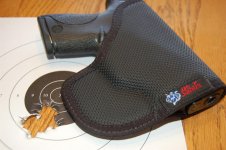Spartikus
Member
- Joined
- Mar 1, 2012
- Messages
- 129
- Reaction score
- 19
I've been shooting for about 5 months or so now and have improved a bit but honestly I walked away frustrated that I was still struggling to have tight 2 inch groups. Typically my groups are probably closer to 4 inches at 25ft. It didn't help that my buddy who doesn't ever shoot came with me and was hitting everything he wanted to almost.
I am very steady but I tend to either jerk the trigger or squeeze my hands when I pull the trigger I think. I tend to hit just left and then a little high or low depending on the shot. I have used the target that tells you what you are doing but I'm just struggling to get it consistent. Anyone have any suggestions or tips on some things I can do to correct these issues?
I know it's practice, practice, practice which is why I shoot 2-3 times a month but willing to try anything. I could use some tips on breath control as that is not something I have really tried to work on yet.
P.S. I am using an M&P9c with an Apex trigger
I am very steady but I tend to either jerk the trigger or squeeze my hands when I pull the trigger I think. I tend to hit just left and then a little high or low depending on the shot. I have used the target that tells you what you are doing but I'm just struggling to get it consistent. Anyone have any suggestions or tips on some things I can do to correct these issues?
I know it's practice, practice, practice which is why I shoot 2-3 times a month but willing to try anything. I could use some tips on breath control as that is not something I have really tried to work on yet.
P.S. I am using an M&P9c with an Apex trigger

